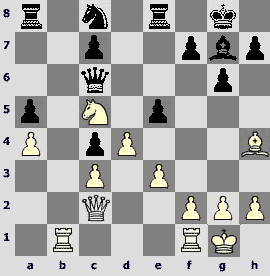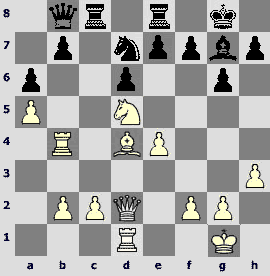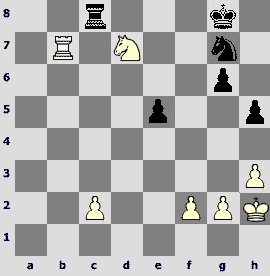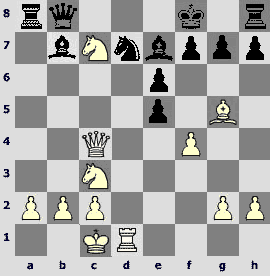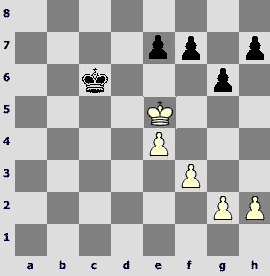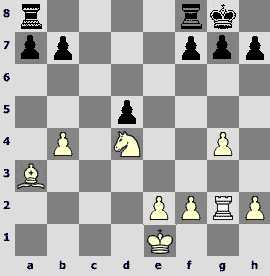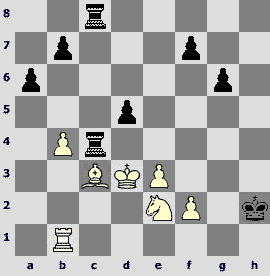14.08.2006
VASSILY YEMELIN. OUR LOT ROBS THE SAVINGS BANK
A traditional tournament in Dortmund ended on August, 6th. To be honest, my impression from the tournament was... Umm, I`d rather say I left completely unimpressed. For some reason, each time I started following the games, it took little time to discover that, instead of analyzing, I am trying to find synonymic words to an adjective "dull". No doubt, games by strong and experienced chess professionals are always exciting, if you care to dig to their subtleties, find out what has been left underwater, what was the opening intrigue before the game, etc. It is so exciting to study a particular opening that occurred in the game, build a variation tree, and study the resulting structure! But okay, chess is an exciting game by itself, no one argues that. However, a mere watcher like me is not interested in seeing skillful maneuvering on the ring, when each boxer is waiting for his opponent to slip on a banana skin. Bloodthirsty public wants exchange of blows and a knock out. Thus I take risk suggesting that most of us, amateurs and professionals, were somewhat disappointed by this tournament. I did not follow the online, but I think the most frequent remark somewhere on the ICC ran as: "Garry/Topa (characteristic familiarity) would have turned them to pieces with +5!"
Such "untimely" reaction is highly understandable. For years the best fighters clinched in scheduled encounters, with each of their meek moves (presumably) showing extreme dynamic potential and indomitable power, combined with the deepest penetration into the core of the position. Of course, the slightest inaccuracy in such a top-end performance is costly. A perfect play ends with the opponents sharing the point. But suddenly appears a man, who acquires the reputation of an android soon, and simply tries to beat these heroes with any color at any given time. Andhesucceeds! Nocomment. I would only like to add that I like the nick "android" very much, exactly because I consider presently popular hints about the champion using computer aid completely irrelevant. Suspecting a marathon champion using an implanted hydraulic gear would be the last thing to consider, right?
However, I should better return to the tournament and discuss the participants` performance in order of the result shown.
Vladimir Kramnik`s participation had intrigued the crowd. I don`t think his play disappointed his supporters. He advanced safely and without the slightest risk, but not without certain feel of fabulosity and monumentality – exactly as a champion should. A key last round victory was achieved in a principled encounter against the leader.
V.Kramnik (2743) - P.Leko (2738) (E32)
1.d4 ¤f6 2.c4 e6 3.¤c3 Ґb4 4.Јc2 0-0 5.a3 Ґxc3+ 6.Јxc3 b6 7.Ґg5 Ґb7 8.f3 h6 9.Ґh4 d5 10.e3 ¤bd7 11.cxd5 ¤xd5 12.Ґxd8 ¤xc3 13.Ґh4 ¤d5 14.Ґf2 c5 15.e4 ¤e7 16.¤e2 ¦ac8 17.¤c3 cxd4 18.Ґxd4 ¤c5 19.¦d1 ¦fd8 20.Ґe3 The leader of Russian chess knows all ins and out of this quiet variation very well, as his second, famous grandmaster Evgeny Bareev, plays it frequently too.
20...¦xd1+ 21.ўxd1 e5 22.b4! ¤e6 23.ўc2 ¤c6 24.ўb2 ўf8 25.Ґc4 ¤cd4 White has a slight advantage, but the Black`s position is for sure defendable. Here Vladimir selects an unobvious way of strengthening the grid, revealing his deep understanding of an endgame. White trades his strong bishop for the Black`s knight, leaving the bishops of opposite colors on board! However, Black has to fight for a draw.
26.Ґxe6! ¤xe6 27.¤b5 ¦a8 28.a4 There was a self-suggesting 28.¤d6!? Black has two ways of holding the position: 28...Ґa6 29.b5 ¦d8 30.¤xf7 ўxf7 31.bxa6 ¦d3, and White has problems making progress despite his extra pawn, because Black is very active, or 28...ўe7 29.¤xb7 ¦b8, regaining a temporarily sacrificed piece, although after 30.¤a5!? bxa5 31.Ґxa7 ¦b7 32.Ґe3 axb4 33.a4 Black still has to defend accurately and actively. Kramnik selects a less forced continuation.
28...Ґa6 29.¤a3! ¦c8 Leko avoids active but risky 29...Ґd3, and possibly it costs him a game.
30.b5 Ґb7 31.¦c1! ¦xc1 32.ўxc1 ўe7 33.a5 bxa5 34.Ґxa7 f5!? Finally Leko finds active counterplay and sacrifices a pawn. However, it is already questionable whether he can escape.
35.exf5 ¤f4 36.g3 ¤h3 Two other attempts should be considered: 36...¤e2+ 37.ўd2 ¤d4 38.Ґxd4 exd4, hoping that a bishop`s advantage over a knight will not allow White converting an extra pawn, or an awkward 36...¤g2, saving the h3-square for the king.
37.¤c4 ¤g5 It is obvious that the b-pawn will cost Black a bishop, and the question is whether he will be able to capture of trade White`s kingside pawns. Leko tries to use his knight for that job, but eventually fails. Simple measures like 37...a4 38.¤xe5 ўf6 or 37...ўf6 38.¤xa5 Ґxf3 should be considered too, but White most likely wins in either case.
38.¤xa5 Ґd5! 39.b6 ¤xf3 40.h3 ¤g5 41.b7 Ґxb7 42.¤xb7 ¤xh3 43.Ґb6!? ўd7 Perhaps a straightforward 43...ўf6 44.¤d6 ўg5 should have been tried.
44.Ґe3 ўe7 45.¤c5 g6 46.fxg6 ўf6 47.Ґxh6 ўxg6 48.Ґe3 1-0 Simplicity and elegance of the White`s play combined with iron logic does not fail to impress.
However, there is still a poor aftertaste. Accurate draws as Black in my opinion can not be subject to criticism. Let us have a look at Vladimir handling the White pieces.
V.Kramnik (2743) - A.Naiditsch (2664) (E04)
1.d4 ¤f6 2.c4 e6 3.g3 d5 4.Ґg2 dxc4 5.¤f3 ¤c6 6.Јa4 ¤d7 7.Јxc4 ¤b6 8.Јb5 This sophisticated hypermodern move provokes a7-a6, in order to weaken the b6-knight position compared to a normal 8.Јd3.
8...Ґd7 After 8...a6 9.Јd3 e5 10.Ґe3 Boris Avrukh won a model game, Avrukh-Berg, Bajada de la Virgen 2005, 1-0 (48).
9.Јb3 ¤a5 10.Јd3! Here comes Kramnik`s improvement! Naiditsch played two games on the subject in 2005, and after 10.Јc2 ¦c8 defeated both Avrukh and Nielsen.
10...c5?! 11.dxc5 Ґxc5 12.Јc3 ¦c8 13.Јxg7 An alternative capture is wrong: 13.Јxa5? Ґb4+ 14.Јxb4 ¦xc1+ 15.ўd2 ¦c4 16.Јd6 (after 16.Јa3 Black has a choice between a forced draw 16...Ґa4+ 17.Јd3 ¦c2+ and a promising attempt of developing the initiative – 16...Ґc6+ 17.Јd3 0-0, threatening Ґxf3) 16...¦c2+!? (less ambitious16...¦c6 17.Јf4 ¦c4 guarantees either a draw by perpetual or regaining a piece with excellent chances after 18.¤d4 f6) 17.ўd1 ¦xe2 18.Јd4 (the computer prefers 18.Јc5! ¤a4 19.Јd4 e5 20.¤xe5 Ґb5, but Black still has initiative) 18...e5 19.Јh4 ¦xf2! (of course not 19...Јxh4 20.¤xh4 ¦xf2 21.¤d2), and suddenly White faces serious difficulties – after 20.Јxd8+ ўxd8 21.¤xe5 ¦e8 22.¤xd7 ¤c4-/+ his disconnected army is unable to defend the king even in the endgame.
13...Ґf8
A critical moment. What if White takes the rook? The analysis failed to provide Black with an adequate reply: 14.Јxh8 ¦xc1+ 15.ўd2 ¦xh1 (15...¦c8 16.¤c3 Јe7 17.¦hc1) 16.Ґxh1 Ґa4+ 17.Јd4 Ґg7 18.Јxd8+ ўxd8 19.¤c3 ¤ac4+ 20.ўe1+/-, and White should win this. However, the champion ducks the risky but principled challenge.
14.Јg5 Јxg5 15.Ґxg5 Ґg7 16.¤bd2 h6! A useful intermediate move.
17.Ґf4 17.Ґe3 Ґxb2 18.¦b1 Ґg7 promised nothing. With the text-move White controls the e5-square.
17...Ґxb2 18.¦b1 ¤d5 Black plans to win an important tempo compared to the variation 18...Ґg7 19.Ґe5, however, Ґf4-e5 is still a safe response.
19.Ґd6 Ґg7 Immediate19...¦c2 is also possible. It is important that Black does not lose material after a principled 20.ўd1 Ґa4 21.¤b3 ¦c6 22.¦xb2 ¦xd6. I think in this position Black`s initiative due to shaky position of the White`s king must balance a disadvantage of spoiled pawn structure.
20.¤e5 ¤c3 Rejecting 20...¦c2 here is difficult to understand.
21.¦c1 ¤xa2 22.¦xc8+ Ґxc8 23.0-0 One should have played 23.Ґf3! The threat Ґf3-h5 is quite unpleasant, and in case of mechanical defending 23... h5 the fact that the e2-pawn is protected, begins to tell in the lines like 24.0-0 ¤c3?? 25.¦c1. After the text-move, the game ends in a draw almost by force.
23...¤c3 24.¦a1 ¤b5 25.¦xa5 ¤xd6 26.¤ec4 ўe7 27.¦xa7 Ґd4 28.¦a8 Black has no time to utilize his two bishop advantage and a remote passed pawn. The forced line ends in a drawn pawn ending.
28...¤xc4 29.¤xc4 b5 30.e3 Ґd7 31.exd4 ¦xa8 32.Ґxa8 bxc4 33.ўf1= ўd6 34.ўe2 Ґc6 35.Ґxc6 ўxc6 36.ўd2 ўd5 37.ўc3 ўe4 38.ўxc4 ўf3 39.d5 exd5+ 40.ўxd5 ўxf2 41.ўe5 ўg2 42.ўf6 ўxh2 43.ўxf7 ўxg3 44.ўg6 1/2-1/2
V.Kramnik (2743) - M.Adams (2732) (C42)
1.e4 e5 2.¤f3 ¤f6 3.¤xe5 d6 4.¤f3 ¤xe4 5.¤c3 ¤xc3 6.dxc3 Ґe7 7.Ґf4 ¤c6 8.Јd2 Ґe6 9.0-0-0 Јd7 10.ўb1 a6 11.¤g5 Ґxg5 12.Ґxg5 f6 13.Ґe3 0-0-0 14.b3 ¦he8 15.f3 h5 16.Ґf2 Ґf5 17.Ґe2 ¦e7 18.¦he1 ¦de8 19.Ґf1 ¦xe1 20.Ґxe1 ¦e7 21.Ґf2 Јe8 22.c4 a5 23.a3 b6 24.Јc3 24.b4 axb4 25.axb4 ¤e5 26.c5 dxc5 27.bxc5 ¦d7 is premature.
24...¤b8
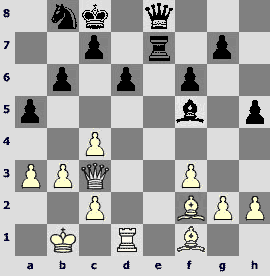
25.ўb2 If White seriously wants to achieve anything, he won`t go anywhere without playing on the queenside. It seems this is the most appropriate moment to start the action: 25.b4!? Maybe с4-с5 is not very topical, but at least the rook gets its open file, which can be utilized after, say, 25...axb4 26.axb4 Јc6 27.b5 Јe8 (27...Јb7 is met by annoying 28.Ґd3) 28.ўb2, with certain initiative.
25...Јc6 26.Јd2 Here after 26.b4 axb4 27.axb4 ¤d7 28.b5 Јb7 29.Ґd3 Ґxd3 30.Јxd3 one has to consider 30...¤e5 with counterplay.
26...¤d7 27.Јd5 ¤e5 28.¦e1 Ґe6 29.Јd2 Јe8 30.f4 ¤c6 31.Ґd3 It looks like White could play 31.b4 axb4 32.axb4 Ґf5 33.¦a1, with at least some action on board.
31...Ґf7 32.¦xe7 Јxe7 33.Јd1 ўb8 34.Јf3 ¤d8 35.Ґe4 f5 36.Ґd3 g6 37.g3 Ґe8 38.Јe3 Јxe3 39.Ґxe3 ¤e6 40.b4 axb4 41.axb4 c5 1/2-1/2
It is not quite clear what Kramnik demanded of the position, but for me as a spectator not versed in superhuman chess understanding, it looked like there was no play at all.
The tendency of avoiding complications and the slightest degree of risk is alarming. I can`t get away from the feeling that had Jobava accurately held his position as White, Vladimir could end the tournament with 7 draws. Perhaps Kramnik`s performance can be summarized as follows: the champion achieved (presumably) certain preparational tasks, while the tournament somehow fell into his hands all by itself.
The tiebreak left Svidler with scraps of the finishing tape. A brief look at his games leaves sluggish impression, but it would be unfair to blame Peter with refusal to fight. He met Jobava, when the Georgian was not an outsider – there are no underdogs in the first round, – and managed to reverse an unfavorable trend of the game, striking the keynote of his and, alas, Jobava`s further performance in Dortmund.
B.Jobava (2651) - P.Svidler (2742) (D80)
1.d4 ¤f6 2.c4 g6 3.¤c3 d5 4.Ґg5 ¤e4 5.Ґh4 ¤xc3 6.bxc3 dxc4 7.e3 Јd5 8.Ґe2 An interesting and probably important nuance, preventing an immediate b7-b5.
8...Ґg7 There is such game in the database: 8...Јa5 9.Јc1 Ґe6 10.¤f3 ¤d7 11.0-0 ¤b6 12.e4 f6, Gostisa-Кozul, Portoroz 1994, 0-1 (35). I think Jobava would be hapy to see something like this.
9.¤f3 ¤d7 10.0-0 ¤b6 11.a4 a5 12.¤d2 Јc6 Can`t Black play 12...e5!? at once, in order not to lose a tempo for Јd5-c6-e6? Let`s see: 13.dxe5 looks dangerous for Black (in my opinion, White is also better after 13.e4 Јd6 14.Ґg3) 13...0-0 14.f4 (14.¤xc4 Јxd1 15.¦fxd1 ¤xc4 16.Ґxc4 Ґxe5 must not scare Black off) White`s central advantage becomes overwhelming, one cannot lose time: 14...Ґd7! Thepositionisunclear. At least a straightforward line 15.¤xc4 Јxd1 16.¦fxd1 Ґxa4 17.¤xb6 Ґxd1 18.¤xa8 Ґxe2 19.¦xa5 ¦c8 leads to a position in which only White may have problems, despite having an extra pawn. Overall, the idea looks too risky for such a modest goal – avoiding a tempo loss. A little joke: the computer suggests a highly imaginative 12...h5.
13.Јc2 e5 14.Ґf3 Јe6 15.¤e4 0-0 16.¤c5 Јe8 17.Ґxb7 After 17.¤xb7 Ґf5 the bishops has to be allowed by d3, because 18.e4? is bad – 18...Ґc8; on 17.Ґg3 Black can think about "anti-positional" 17...f5 as well as "greedy" 17...¦a7, so the pawn should be taken.
17...Ґxb7 18.¤xb7 Јc6 19.¤c5 ¦fe8 19...f5!? with the idea to attack the White`s center is a bit too risky.
20.¦ab1 ¤c8
Peter slowly refines his position, which looked quite suspect in the opening.
21.¤b7 Jobava temporarily prevents the Black`s maneuver. Peter "blackmails" the young aggressor with the move repetition, and...
21...¤b6 22.¤c5 ¤c8 23.¦fd1!? White wants to fight! A natural 23.f3 with the idea Ґh4-f2 led to weakening of the e3-square, and after 23...¤d6 24.Ґf2 e4 25.Ґg3 Ґh6 Black enjoys some counterplay.
23...¤d6 24.Ґg3 h5 25.Јb2 Ґf6 26.h3 A more precise order of moves 26.Јa3 ¦e7 27.d5 Јe8 28.h3 prevented pinning the c5-knight.
26...¦e7 27.Јa3 ¤f5 28.d5 White could abstain from this demanding advance by 28.Ґh2, however 28...exd4 29.cxd4 ¦ae8 led to increase of the tension. Black prepares captures on e3 and d4, and it is not easy for White to avoid playing d4-d5. The text-move provokes complications, in which White has to be careful because of the c5-knight vulnerability.
28...Јd6 29.Ґh2 ¦ee8 30.e4 ¤g7 31.¦d4 Such non-trivial measures a forced.
31...¦ab8 Black could play for winning an exchange by 31...¦eb8 32.¦a1 ¤e8 33.¦xc4 Јe7 34.Јa2 ¤d6 35.¤d3. However, White has a compensation here.
32.¦a1 Ґe7 Simpler is 32...c6 33.¦xc4 cxd5 34.exd5 Јxd5 35.¤e4 Ґe7, and Black is better.
33.¦xc4 c6 34.Јa2 cxd5 35.¦d1 Јb6 36.¤d7 Јb7 37.Ґxe5 It seems Jobava spent all his optimism in this game. He should have been more reserved: 37.¤c5 Јb6 with a draw by repetition.
37...dxc4 38.Ґxb8 Looks like a time trouble error. Correct 38.¤xb8 led to the position in the game after 38...¦xb8, while 38...Јxe4 39.¤d7 is harmless for White, because 39...¦d8?! isstronglymetby 40.Ґc7! Now Black could substantially improve his position compared to the game by an intermediate 38...¦d8! After 39.Јd2 ¦xb8 40.¤xb8 Јxb8, the c4-pawn is still alive, and Black has an advantage. However, the game continued
38...¦xb8 39.¤xb8 Јxb8 40.Јxc4 ¤e6 White`s weak pawns and certain chances to attack the king determine Black`s small advantage in the position. White can`t hope trading the queens.
41.Јb5 Јf4 42.Јe8+ Ґf8 43.¦d7 h4!?
After 43...¤g7 44.Јa8 Јc1+ 45.ўh2 Јxc3 46.¦d5=/+ Black regains a pawn, but limited material keeps his advantage marginal. Peter made a useful move, securing his chances to bother the opponent`s king as soon as he unpins his pieces. However, White could prevent the unpinning by a paradoxal 44.f3!! (what a horrible weakening of the dark squares!) 44...¤g7 (44...ўg7 45.Јxe6 Ґc5+ 46.ўf1 Јc1+=; 44...¤c5 45.¦d8; 44...¤c7 45.Јc8 ¤e6 46.Јe8) 45.Јc8 ¤h5 46.¦d8; there is no alternative: 44.c4?! ¤g7 45.Јd8 Јxe4 46.Јxa5 ¤e6 with advantage. However, White fails to find this study-like solution, and his game quickly deteriorates: 44.¦a7? ¤g7! 45.Јd8 Јxe4 46.Јd1 Јe5 47.Јd2 ¤f5 48.ўf1 ўg7 49.Јd3 Јf4 50.Јf3 Јc4+-+ 51.ўe1 (51.ўg1 Јxa4) 51...¤d4! (51...Ґb4!-+) 52.Јd1 Јxc3+ 53.ўf1 Ґc5 54.¦c7 ¤e6 55.¦b7 ¤f4 56.ўg1 Ґxf2+ 0-1
In my opinion, Svidler`s performance looks blurry because his White openings were ineffective. I dare to suppose Peter had no idea how to deal with Leko`s Najdorf, and if you can pose more problems for Kramnik`s Petroff than he did, you probably can qualify to Dortmund via the Aeroflot open... His last White game suffered from foretaste of the first place finish. Thus the famous St. Petersburg player ran out of Whites, but his confident and safe Black play earned him two wins, after the opponents misstepped in search of the win. Overall a decent performance! It is worth noting an important victory over a previously difficult opponent.
L.Aronian (2761) - P.Svidler (2742) (D80)
1.d4 ¤f6 2.c4 g6 3.¤c3 d5 4.Ґg5 ¤e4 5.Ґh4 ¤xc3 6.bxc3 dxc4 7.e3 Ґe6 8.Јb1 Јd5 9.¤f3 ¤d7 10.Ґe2 Ґf5 11.Јb2 Ґg7 12.0-0 e5 13.Јb4 c5 14.Јxc4 Јxc4 15.Ґxc4 A sharp middlegame arose directly of the opening. Black facing problems due to awkward position of the f5-bishop as well as White`s clear plan of adding the pressure by Ґc4-d5 and Ґh4-g3.
15...¦c8 Peter chooses the most natural path. He had an interesting way of cutting the Gordian knot, shown by grandmaster Shipov: 15...exd4!? 16.exd4 0-0 17.Ґd5 ¦ab8 18.Ґg3. It looks like Black must regret about unwisely opening of the h2-b8-diagonal, but... 18...¤b6! 19.Ґxb8 ¦xb8, and Black has a good compensation for an exchange after both 20.Ґb3 c4 21.Ґd1 ¤d5, and 20.c4 cxd4.
16.Ґd5 Ґd3 Black solves one of his problems. The Petersburger conducts the game exaggerately accurately, avoiding unnecessary complications. For instant, he had an aggressive 16...b5, but although 17.¤g5 exd4 18.¤xf7 is met by 18...¤b6! with unclear play, 18.e4!? isquitedangerousforBlack. A simple 16...b6 led to difficulties after 17.¤g5, and the f5-bishop is in danger.
17.¦fd1 Ґa6 18.¦ab1 b6 19.Ґg3 cxd4 Now a simple 20.cxd4 recapture gives White a certain edge, but the leader of the Armenian team selects highly imaginative and aggressive, but not exactly sound plan.
20.exd4?! Now Peter demonstrates that he also knows tactical kung fu:
20...¤f6! 21.Ґb3 21.Ґxe5 ¤xd5 22.Ґxg7 ¦g8 is in Black`s favor.
21...¤e4 22.¦e1 ¤xc3 23.¦b2 White probably has more chances to equalize after 23.Ґxe5 0-0) 23...e4=/+ 24.¤g5 Ґc4! (and again Black is not interested in complications: 24...0-0 25.Ґd6 Ґxd4 26.Ґxf8 ¦xf8 27.¦d2 Ґd3 28.Ґc2, and White has counterchances.
25.¤xe4 ¤xe4 26.¦xe4+ ўd8 27.Ґf4 Ґxb3 28.¦xb3 ¦e8 The position has been defined. Black has a clear endgame advantage. Aronian failed to defend.
29.¦xe8+ ўxe8 30.d5 ¦c4 31.g3 ¦a4 32.¦e3+ ўd7 33.¦e2 Ґf8 34.ўf1 Ґd6 35.Ґe3 Ґc5 36.Ґf4 ¦d4 37.¦c2 ¦xd5 38.ўe2 b5 39.g4 ўc6 40.Ґe3 ўb6 41.¦d2 ¦xd2+ 42.Ґxd2 b4 43.f3 ўb5 44.ўd3 Ґd6 45.h3 Ґe5 46.Ґe3 a5 47.Ґd2 a4 0-1
And yet, we would rather describe such performance of our renowned Olympian as shared first place in a supertournament with some other words than "favorable circumstances".
Well, the two Russians shared the first place under favorable circumstances. Why not – it is wonderful! And how can one expect finishing first without slight presence of luck?
Adams performance was expectedly melancholic. With four Whites and basically two Blacks (in which he experienced no problems at all), Micky could become a sole winner of the event with +3 score – it is sufficient to look at his positions against Aronian, Gelfand and Naiditsch. Did anyone expect Adams winning this tournament? Can anybody imagine the Englishman tearing his hair because he missed a unique chance of winning in a supertournament? This explains a lot. Micky pressured Aronian, but let the Armenian go. And what about Adams-Jobava game – does it look like favorite`s attempt to beat a shaky tailender? His opening choice is already questionable – Ovechkin`s setup used by Jobava neutralizes that branch of the Panov Attack, and Adams did not show anything to change the assessment. Some pressure on Naiditsch, some pressure on Gelfand... His win against Gelfand seems to be a matter of pure statistics – at least one of those small advantages had to convert into a point! Moreover, he could be deprived of it, had Gelfand use an accidental chance.
M.Adams (2732) - B.Gelfand (2729) (В90)
1.e4 c5 2.¤f3 d6 3.d4 cxd4 4.¤xd4 ¤f6 5.¤c3 a6 6.a4 g6 7.Ґe2 Ґg7 8.0-0 0-0 9.Ґe3 ¤c6 10.Јd2 ¤xd4 11.Ґxd4 Ґe6 12.a5 Gelfand already had problems in this variation:12.¦fd1 ¦c8 13.f3 Ґc4 14.a5 Vallejo Pons-Gelfand, Amber rapid 2006, 1-0 (52). Adams improves the White`s plan.
12...¦c8 13.Ґd3 Ґc4 Maybe, it is worthy to start with exchanging the dark-squared bishops: 13...¤d7. Gelfand follows the plan used against Vallejo.
14.¦fd1 Јc7 15.h3 ¦fe8 16.Ґxc4 Јxc4 17.¦a4 Јc6 18.¦b4 Јc7 Once again it seems to me that 18...¤d7 is more accurate: 19.Ґxg7 ўxg7 20.Јd4+ ўg8 21.¦d2+/=, keeping the queen on a more active square. Natural-looking 21.¤d5 leads to a draw after exchange of tactical blows, just like most lengthy forced lines: 21...Јxc2 22.¦xb7 ¦c4 23.¤xe7+ ¦xe7 24.Јxd6 ¦cxe4 25.¦xd7 ¦e1+ 26.¦xe1 ¦xe1+ 27.ўh2 Јxf2 28.¦d8+ ўg7 29.Јf8+ ўf6 30.Јd6+= (30.Јh8+ ўg5).
19.¦b6 ¤d7 20.¤d5 Јb8 21.¦b4+/- It is time to conclude: the opening did not work out for Black. White`s advantage is obvious.
21...¤e5 22.¦a4 ¦c4 23.¦xc4 ¤xc4 24.Јc3 Ґxd4 25.¦xd4 ¤e5 26.¦b4 ¤c6 27.¦b6 Јc8 The simplifications only made the Black`s task harder. All his pieces are loaded with defensive duties. Adams finds the way to increase the pessure, and the remaining Black`s forces turn unable to hold the balance.
28.b4! Јd7 29.b5! axb5 30.a6 b4 31.Јa1?! There was a clear-cut win:31.Јc4! ¤e5 32.¦xb7! Јxb7 33.axb7 ¤xc4 34.¤xe7+ ўg7 35.¤c8+-.
31...bxa6 32.Јxa6 ¤d4 33.¦xb4 ¤e6?! The game returns to a course that was predetermined by the preceding play. Black misses an excellent chance to punish White for his imprecision on the 31st move. 33...Јc6! forces exchange of the queens, and after 34.Јxc6 (34.Јa7 ¤e2+ 35.ўh2 Јxc2 36.¤xe7+ ўg7 37.f3 ¦xe7 38.Јxe7 Јc1 39.Јa7 Јf4 yields nothing) 34...¤xc6 35.¦c4 ¤b8 Black has great drawing chances.
34.¦b7 Јc8 35.Јb5! 35.Јa7 also gives an advantage close to being decisive: 35...Јxc2 36.¤xe7+ ўh8! 37.¦b8 ¤g7 (37...¦xb8 38.Јxb8+ ўg7 39.Јg8+ ўf6 40.¤d5+ ўg5 41.Јxf7 Јb1+ 42.ўh2 Јxe4 43.Јe7+ ўh6 44.¤e3) 38.¤d5! Јxe4 39.¤c7 Јe7 40.Јb7+/- ¦f8 41.¤e6!, however, the solution in the game is incomparably clearer.
35...ўf8 After 35...¤d4 36.Јb2 Јc5 (36...¤c6 37.Јb6) the e7-pawn falls. The most direct is, naturally, an inhuman 37.ўh2 ¤f3 38.ўg3... although a casual 37.c3 ¤c6 38.¦c7 should suffice, too.
36.Јb2 ¤g7 37.¤xe7 Јc4 After 37...Јe6 White wins a pawn by 38.¤d5 Јxe4 39.¤f6 Јe1+ 40.ўh2, keeping all his threats.
38.Јf6 38.¤d5 would transpose to the line above.
38...Јxe4 39.¤f5 Јe1+ 40.ўh2 Јe5+ 41.Јxe5 dxe5 One wants to advise 41...¦xe5 42.¤xd6 ¤f5 followed by ¦e2.
42.¤d6 ¦d8 42...¦e7 does not save – 43.¦b8+ ¤e8 44.c4+-, and Black cannot get rid of the pin.
43.¤xf7 ¦c8 43...¦d2 looks natural even for the computer...
44.¤g5! h5 White remains with two extra pawns after both 44...¦xc2 45.¤xh7+ ўg8 46.¤f6+ ўf8 47.¤d7+, and 44...h6 45.¤h7+ ўg8 46.¤f6+ ўf8 47.c4! e4 48.c5 ¤e6 49.¦b5 xe4.
45.¤h7+ ўg8 46.¤f6+ ўf8 47.¤h7+ ўg8 48.¤f6+ ўf8 49.¤d7+ ўg8
Attention! After 50.¤xe5 ¦xc2 we approach a true study: 51.¤xg6 ¦xf2 52.¦b8+ ўh7 53.¤f8+ ўh6 (53...ўg8 54.¤e6+) 54.¦b6+ ўg5 55.¦g6+ ўh4 – the Black`s king is in the mating net, and all we have to do is avoid stalemate threats: 56.¤d7 ¤f5 57.¤e5 ¤d4 58.¦g3!+- (or 58.¦d6 ¤f5 59.¦d2!). By missing another forced solution, Adams significantly complicates his task.
50...ўf7 51.¤xe5+ ўf6 52.¤f3 ¤e6 53.¦b6 On 53.h4 White was probably concerned by 53...¦c3.
53...ўe7 54.¤e5 g5 55.c4 h4 56.¦b7+ ўf6 57.¤g4+ ўg6 58.¦b6 ўf7 59.¦b7+ ўg6 60.¤e3 ¦a8 61.¦b6 ўf7 62.g3 ¦a2 63.ўg2 hxg3 64.ўxg3 ¤c5 65.ўf3 ¤d3 66.¤g4 ўe7 67.¦b3 ¤c5 68.¦e3+ ўf7 69.¤e5+ ўf6 70.¤g4+ ўg6 71.¦e5 ¦a3+ 72.¤e3 ¤d3 73.¦d5 ¦c3 74.¦d4 ¦a3 75.h4 gxh4 76.¦xh4 ¦a2 77.¦h2 ўf6 78.ўe4 ¤c5+ 79.ўd5 ¤b3 80.f3 ¦a5+ 81.ўe4 ¤c5+ 82.ўf4 ¤e6+ 83.ўg3 ¦a3 84.¦e2 ўg5 85.¤c2 ¦a6 86.¤b4 ¦b6 87.¤d5 ¦d6 88.¦e5+ ўh6 89.¤f4 ¤c7 90.c5 ¦c6 91.ўg4 ўg7 92.ўf5 ўf7 93.ўe4 ¦a6 94.¦f5+ ўe8 95.ўe5 ¦c6 96.¤d3 ўe7 97.¦h5 ¦e6+ 98.ўd4 ¦f6 99.f4 ¦a6 100.¦h7+ ўd8 101.f5 ¤e8 102.¤b4 ¦a1 103.¤c6+ ўc8 104.¦h8 ўd7 105.¤e5+ ўe7 106.¤g6+ ўd8 107.ўd5 ¦e1 This endgame is not that simple, and Adams` technique was impeccable... up to this moment.
108.c6 White complicates the issue again. Much simpler is 108.f6 ¦f1, and now either 109.ўe5 with the idea to interpose by ¤f4, or a pleasant-looking "axe-effective" 109.¦xe8+ ўxe8 110.ўe6.
108...¦d1+ 109.ўe5 ўc7 110.¦xe8! ¦e1+ 111.ўd5 ¦xe8 112.f6? What a titanic effort could be spoiled by this move! White wins by a non-trivial 112.¤f4 with the ideas f5-f6 or driving the king away by ўc5, and ¤d5. Now Black suddenly gets a chance to drive the White`s king away and survive!
112...¦d8+ 113.ўc5 ¦d1? 113 moves against Adams – this is too much. After a correct 113...¦a8! Black would triumph: 114.¤e5 ¦a5+ 115.ўd4 ўd6!! 116.¤c4+ (neither helps 116.f7 ¦a8) 116...ўxc6 117.¤xa5+ ўd6, and the last pawn falls.
114.f7 ¦c1+ 115.ўd5 ¦d1+ 116.ўe6 ¦f1 117.¤e7 1-0
Adams shared the third place with Leko and Gelfand. Their tournament fates are different. Leko`s play appealed to me most of all the participants. There is a feeling that the first round games stroke a keynote in the subsequent performance of each player. Peter won his game in complex and interesting struggle:
P.Leko (2738) - A.Naiditsch (2664) (E11)
1.d4 ¤f6 2.c4 e6 3.g3 Ґb4+ 4.Ґd2 c5 5.Ґxb4 cxb4 6.Ґg2 0-0 7.¤f3 White can avoid transposing into the Bogo-Indian defense by 7.e4 d6 8.¤e2, and this attempt is perfectly justified – a prospect of seeing four White`s pawns in the center is hardly pleasing for most of Blacks...
7...d6 8.0-0 ¤c6 9.d5 exd5 10.cxd5 ¤e7 11.¤h4 11.¤e1 was played earlier, but without much success.
11...Јb6 12.e4 Ґg4 13.Јb3
White`s last move is explained by the fact that after 13.Јd3 ¤d7 the knight goes to e5 with a tempo, giving Black active play. However, now Black could try winning a central pawn by 13...g5!?, and I think he should have taken this risk. Later it will be difficult to find another way to improve. White is forced to 14.¤f3, because an immediate 14.¤f5 ¤xf5 15.exf5 ¦fe8 gives Black a good game, while an intermediate 14.h3 gives Black a choice between two promising replies: 14...Ґxh3!? or 14...Ґd715.¤f5 ¤xf5 16.exf5 ¦fe8. After 14.¤f3 ¤xe4 15.¤bd2 Ґxf3 (15...¤xd2 16.¤xd2 gives White full compensation) White has to follow Landa`s advice and sacrifice an exchange:16.¤xf3 (16.¤xe4 Ґxe4 17.Ґxe4 ¤g6 does not pose any problems) 16...g4 17.¤h4 ¤d2 18.Јd1 ¤xf1 19.Јxg4+ with unclear consequences.
After selected careful 13...a5 White`s long-term advantages prevailed over Black`s dynamic counter-arguments:
14.h3 a4 15.Јd3 Ґd7 16.¦e1 ¦fc8 17.¤f3 ¤g6 Seizing the file with two rooks does not give Black anything: 17...¦c7 18.¤bd2 ¦ac8 19.Јd4
18.¤bd2 a3 The alternative 18...h5?! looks even less convincing.
19.¦ab1! White prevents the opponent`s counterplay, which could occur after 19.bxa3 ¦xa3 20.Јd4 Јxd4 21.¤xd4 ¤e5.
19...Ґa4 I tend to consider this move unsuccessful. The bishop simply comes under attacks, giving White time to consolidate. One should have tried 19...Јc5 20.Јd4 Јxd4 21.¤xd4 axb2 (after 21...¤e5 White has 22.Ґf1 as well as a tempting 22.bxa3!? ¦xa3 23.f4) 22.¦xb2 ¤e5 23.Ґf1 ¦c3 – Black has active counterplay.
20.Јd4 Јxd4 21.¤xd4 Ґc2 22.¦bc1 Ґd3 23.¦xc8+ ¦xc8 24.bxa3 bxa3 25.f4 h5 26.¦e3 Breaking through the center is clearly premature: 26.e5? dxe5 27.fxe5 ¤xd5! 28.Ґxd5 ¦d8, and Black is okay.
26...Ґa6 27.ўf2 h4 28.Ґf3 ¦c1?! Surprisingly, Black could defend against e4-e5-e6-e7 by 28...ўf8, and after 29.¦xa3 ¦c1 he had chances to survive. Now his position becomes really dire.
29.e5! dxe5 On 29...¤d7 (provoking 30.e6 ¤f6 31.e7 ¤xe7 32.¦xe7 ¦a1) White will just capture on d6: 30.exd6, and Black will hardly manage blocking this pawns for long. 29...¤e8 keeps the material, but poor arrangement of Black`s minor pieces leaves no doubt about the outcome. Now, however, the game ends by force.
30.fxe5 ¤d7 31.e6 fxe6 32.dxe6 ¤de5 33.e7 ¦c8 34.Ґh5 Black loses material. 1-0
I do not consider Leko`s win over Aronian a positional masterpiece. The Aronian`s position was too passive, and the opponent`s general plan was too obvious. However, there is no harm in admiring Leko`s technique and try to learn from him!
Leko clearly has reasons to be unhappy about the tournament results. All he needed is to hold against Kramnik in the final round... Doesn`t it sound familiar? However, it is in such situations one could see who is the champion, and who is merely "not weaker" than the champion.
Gelfand failed to convince at the start. Two draws with White were made under the motto "No opening advantage, no play", and in the second round he lacked either energy or time to convert an extra piece...
A.Naiditsch (2664) - B.Gelfand (2729) (B96)
1.e4 c5 2.¤f3 d6 3.d4 cxd4 4.¤xd4 ¤f6 5.¤c3 a6 6.Ґg5 e6 7.f4 ¤bd7 8.Јf3 Јc7 9.0-0-0 b5 10.Ґxb5 axb5 11.¤dxb5 Јb8 12.e5 Ґb7 13.Јe2 dxe5 14.Јc4 Ґe7 15.¤c7+ ўf8 16.¦xd7 ¤xd7 17.¦d1
17...Ґd5 17...Ґxg5 18.fxg5 Ґc8 occurred in Bengis-Dvoirys, Kislovodsk 1982, 1-0(29). The following line is given in Lepeshkin`s book: "bad is 18...Ґd5? due to 19.¤3xd5 ¦a7 20.¤f6 ¦xc7 21.¤xd7+ ўe7 22.Јd3 Јb4 23.a3 Јf4+ 24.ўb1 e4 25.Јd4 ¦d8 26.g3" No comments. What a great time it was! However, let us return to the position after 19.¤3d5. Why does Black make a weird move 19...¦a7 instead of a natural 19...exd5? Thisiscorrect: 19...exd5 ismetby 20.¦xd5! (20.Јd5 leads to the position in the game) and Black has huge problems. Therefore one has to postpone exchanging on g5.
18.¤3xd5 It seems White should make an almost forced draw by 18.¦xd5 exd5 (18...Ґxg5? 19.¦xd7 Ґxf4+ 20.ўb1+-) 19.Ґxe7+ ўxe7 (19...ўg8 20.Јxd5 ¦a7 21.¤7b5 ¤b6 22.Јd6 Јxd6 23.Ґxd6 leads to an unclear game. White has three pawns for two exchanges) 20.¤3xd5+ ўd8 (20...ўf8 21.Јc6!?) 21.¤xa8 Јxa8 22.Јc7+ ўe8 23.Јd6=.
18...exd5 19.Јxd5 This does not favor White without including Ґxg5, fxg5 (19.¦xd5 is no good. Apart from 19...¤f6 and 19...¦xa2 there is a forced line 19...¤b6 20.Ґxe7+ ўg8 21.¦d8+ Јxd8 22.Ґxd8 ¤xc4 23.¤xa8 exf4-/+). After 19...Ґxg5 20.fxg5 ¦xa2! 21.Јxa2 Јxc7 Black clearly plays for a win.
22.Јa3+ ўe8 23.¦d3 ўd8 There are few tempting continuations: 23...¦f8; 23...Јd8; 23...h6. It is not easy to find the truth, but objectively speaking White`s resources should not suffice. Gelfand, however, makes a practical decision, possibly influenced by his lack of time, and the game ends
24.Јa8+ Јc8 25.Јa5+ Јc7 26.Јa8+ Јc8 27.Јa5+ 1/2-1/2
In the Round 4 Boris loses in relatively harmless system of his favorite Najdorf. No good news for the 6.a4 devotee – next time Gelfand will show a clear-cut equality for Black. However, persistent struggle for a win in the 5th round (against the least successful player of the tournament) leads to a fortunate victory:
B.Gelfand (2729) - B.Jobava (2651) (B39)
I`d rather not offend the player who had Black pieces, calling this ending a dead draw. Itisdrawnindeed, butBlackhasthingstoconsider. Nevertheless, his position is qutie solid, and there are not too many only moves to find.
48...ўd7 49.f4 ўe8 Let`s study the following line: 49...ўc6 50.g4 h6 51.h4 (a "finesse" 51.h3 changes nothing, Black can play both 51...ўd7 52.ўd5 g5 53.f5 ўc7 54.e5 ўd7=, and 51...ўc5 52.h4 ўc6 53.g5 (53.f5 g5 54.hxg5 hxg5=) 53...hxg5 54.hxg5 ўd7 55.f5 gxf5 56.exf5 ўe8) 51...ўc5 52.g5 hxg5 53.hxg5 ўc6 54.f5. White conducted a plan, but there is too little material left, 54...gxf5 55.exf5 ўd7=.
50.h4 Let us add another important drawn position: 50.ўd5 ўd7 (51.g4 h6) 51.f5 gf5! 52.ef5 f6. White cannot win without the 9th rank. So, it is clear already that had Black played 50...ўd7, it would make a draw business a lot easier. However, Baadur tried to find a more direct approach.
50...h5?? 51.f5! f6+ 52.ўe6 gxf5 53.e5! Probably Black missed this resource, and ended up in a lost queen ending as a result.
fxe5 54.ўxe5 ўd7 55.ўxf5 ўd6 56.ўg5 ўe5 57.ўxh5 ўf4 58.ўg6 e5 59.h5 e4 60.h6 e3 61.h7 e2 62.h8Ј e1Ј 63.Јb8+ ўg4 64.Јc8+ ўg3 65.Јh3+ ўf4 66.Јf5+ ўg3 67.Јh3+ ўf4 68.Јf3+. White has excellent winning chances. Black did not survive... 1-0
Having sensed his good fortune as well as clear decline of form of the next opponent, Gelfand played a masterpiece game in the final round.
B.Gelfand (2729) - L.Aronian (2761) (E15)
1.d4 ¤f6 2.c4 e6 3.¤f3 b6 4.g3 Ґa6 5.Јc2 Ґb7 6.Ґg2 c5 7.d5!? exd5 8.cxd5 Ґxd5 9.¤c3 Ґc6 10.e4 Ґe7 11.Ґf4 0-0 12.0-0-0 This aggressive plan associated with long castling is the idea of Gelfand. Earlier White castled short.
12...¤a6 13.Јe2 ¤b4 14.a3 Јc8 15.ўb1 a5 It is unclear yet how to confront the new idea. White gets more than sufficient compensation.
Black could trade the queens by 15...Јa6, but after 16.¦he1 Јxe2 17.¦xe2 ¤a6 18.¤e5 ¦ad8 19.¦ed2 White has an edge. Thus Levon tries to confuse the opponent with the Danai knight.
16.¤e5 In vain. Of course, nobody will even consider taking such a knight. But in the analysis... 16.axb4 axb4 17.¤d5 Ґxd5 18.exd5 ¦e8 with compensation; 16.e5 ¤fd5 17.axb4 ¤xc3+ 18.bxc3 axb4 19.cxb4 ¦a4 is not good for White. So, itisofficialnow – theknightistaboo. So what Black can do? There are two fantasy ideas – either prepare d7-d6, or to push the b-pawn to b4. And where should the knight go? Either to a6 or to d3. So...
16...¦e8 Levon prepares d7-d6. Immediate16...d6 runs into 17.¤c4 Јe6 18.¤xb6 (18.¦he1 b5 19.¤xd6 g5!?) 18...¦a6 19.¤c4+/-. Also 17.¤xc6 Јxc6 (17...¤xc6 18.¤d5 with advantage) 18.¦hg1 brings Black problems due to the threat of e5. Although after 18...Јd7 White should limit himself to 19.g4 with initiative, as an attempt to capture everything leads to unclear consequences: 19.axb4 axb4 20.e5 bxc3 21.exf6 Ґxf6 (21...Јa4 22.Ґxa8 ¦xa8 23.fxe7) 22.Ґxa8 ¦xa8 with compensation for the rook; interesting is 16...b5!? 17.g4 (17.¤xb5 Ґxb5 18.Јxb5 d6 19.¤c4 ¦b8 20.Јxa5 Јe6) and now 17...c4 (not good is 17...d6 18.¤xc6 ¤xc6 19.¤xb5 or 17...¤a6 18.g5 ¤e8 19.¤xb5) 18.g5 ¤e8 19.Ґh3 ¤d3 20.¤xd3 cxd3 21.Јxd3 b4 22.¤d5 Ґxd5 23.Јxd5 bxa3 24.Ґxd7 Јa6 25.Јb5 – despite the weakened king, White has an advantage due to dominating pieces.
17.¦he1 Ґf8 (17...d6 18.¤c4) 18.g4 g6 19.Ґg3 ¦e6 20.f4 d6 The desired move is finally made, but after
21.¤xc6 ¤xc6 22.¤b5 ¤e8 it transpired that the Black`s plan has come to grief.
23.e5! An excellent killer move. Gelfand is not interested in immediate material gains by 23.f5!? ¦e5! (23...¦e7 24.e5 dxe5 25.Јe4 Јa6 26.¤d6 (26.Ґh4; 26.fxg6)) 24.Ґxe5 ¤xe5 25.g5+/- with advantage.
23...dxe5 24.Ґd5! More accurate than 24.fxe5 ¤c7 25.¤xc7 Јxc7 26.Ґd5 ¦ae8, which gives Black certain chances.
24...a4 The ending after 24...exf4 25.Ґxe6 Јxe6 26.Јxe6 fxe6 27.Ґxf4 is hopeless for Black; 24...¦e7 does not save the material: 25.Јg2 (25.fxe5 is even stronger, virtually stalemating Black) 25...e4 26.Ґh4; the best is 24...¤c7 25.¤xc7 Јxc7 26.Ґxe6 fxe6 27.Јc4, White should win but Black is still kicking.
25.fxe5 ¤g7 26.Јf3 ¦b8 (26...¦a5 27.¤d6)
27.¤d6 Gelfand finds a neat move. Brutal 27.¦f1 ¤d8 28.Ґh4 Ґe7 29.Ґxe6 Јxe6 30.¤c7! Јxe5 31.¦xd8+ ¦xd8 32.Јxf7+ ўh8 33.Ґxe7 would also do it.
27...Ґxd6 28.exd6 ¤d4 29.¦xd4 ¦xe1+ (29...cxd4 30.Ґxe6 ¤xe6 31.d7) 30.Ґxe1 cxd4 31.Јxf7+ ўh8 32.d7 Јc5 (32...Јf8 33.Јxf8+ ¦xf8 34.Ґh4 x¤g7) 33.Ґb4 1-0
With his performance Boris once again proved that he is still one of the world`s strongest players.
Which player`s performance is the most telling of the tournament? Naiditsch`s! Except his game against Svidler, in which Arkady was lucky to obtain certain winning chances, he had dubious or bad positions in all of his games. However, only Leko had enough will and energy to defeat him. The German "wonder" ended the tournament at 50% – with such course of events it should be regarded as clear success. One can think Naiditsch was simply lucky, but this is deserved luck. Luck is attracted by working, and young German grandmaster defended stubbornly and resourcefully in every game.
L.Aronian (2761) - A.Naiditsch (2664) (E20)
1.d4 ¤f6 2.c4 e6 3.¤c3 Ґb4 4.¤f3 c5 5.g3 0-0 6.Ґg2 cxd4 7.¤xd4 d5 8.cxd5 ¤xd5 9.Јb3 Јb6 10.Ґxd5 exd5 11.Ґe3 Ґh3 12.g4 ¤a6 13.a3!? Earler there was 13.¤f5 Јa5 14.Ґd4 ¤c5 15.Јxd5 ¦fd8 16.Јf3 ¦xd4 L`Ami- Naiditsch, Corus B Wijk aan Zee 2006, 0-1 (48). The text-move is clearly stronger.
13...Јa5 13...Ґxc3+ 14.Јxc3 ¦fc8 (14...¦ac8 15.¤f5!? ¦xc3 16.Ґxb6 ¦c4 17.Ґxa7) does not solve the problem: after15.Јd2 Јg6 White has a number of initiative continuations: 16.f3, 16.¦g1, 16.¤f5...
14.¦c1 Ґxc3+ 15.¦xc3 ¤c5 After 15...Ґxg4? White sharply becomes more active: 16.¦g1 Ґh5 (16...h5 17.f3 ¦fe8 18.Ґd2 Ґd7 (18...¤c5 19.Јb5 Јxb5 20.¤xb5 ¤a4 21.fxg4) 19.¦g5+/-) 17.¦g5 Ґg6 18.¦xd5+/-; 15...¦fc8 is strongly met by a simple 16.¦g1.
16.Јb4 Јxb4 17.axb4 ¤a4 17...¤e4 18.¦d3, and it looks like Black will have to save his h3-bishop at cost of a pawn by h7-h5.
18.¦a3 ¤xb2 19.Ґc1 Ґg2 20.¦g1 ¤c4 21.¦xg2 ¤xa3 22.Ґxa3+/- White has two pieces for a rook and a pawn, which brings him excellent winning chances.
22...¦fc8 23.¦g3 g6!? This natural move restricting the White`s knight also turned a very good provocation: 24.g5 The core of White`s difficulties. It is better to start with improving the pieces, just like Levon did later in the game: 24.¦b3, ўd2, e3 or 24.ўd2 at once.
24...¦c4 25.¦d3 a6 26.ўd2 ¦ac8 27.e3 h6 What should White do with the pawn: trade it or support it by h2-h4? White chooses trading.
28.gxh6 ўh7 29.¦b3 ўxh6 30.Ґb2 ўh5 31.Ґc3 ўg4 32.ўd3 ўh3 33.¤e2 ўxh2 34.¦b1
Comparing the diagrams demonstrates Black`s progress. However, he also ran into a trouble: White`s last move means he started playing for the mate.
34...g5 The computer suggests waiting: 34...¦8c6; running Black is already late: 34...ўh3 35.¤f4+ ўg4 36.¦g1+ ўf5 37.¤xd5 ўe6 38.e4, and White`s activity gives him every reason to believe that this position is won for him.
35.f4 It is unlikely to calculate, but it is possible to believe and play the following line up to the victory, move by move: 35.Ґe5+ ўh3 36.¦h1+ ўg2 (36...ўg4 37.¤d4) 37.¦g1+ ўxf2 38.¦xg5 ¦e8 (38...¦xb4 drops a rook: 39.Ґg3+ ўf1 (39...ўf3 40.¤g1+) 40.¦f5+ ўg2 41.¦f2+ ўh3 42.¦h2+ ўg4 43.¦h4+ – an important variation!) 39.¦f5+ ўg2 40.¤f4+ ўh1 41.¦h5+ ўg1 42.¦g5+ ўh1 43.¤e2 ¦xe5 44.¦xe5 ¦xb4 45.¦xd5+-.
35...g4 It feels White has missed the win.
36.Ґe1 Let us study another line: 36.f5 ¦xc3+! 37.¤xc3 g3 38.¤e2 g2. It is White who has problems. This position is full of ideas similar to the line above.
36...ўg2 37.Ґg3 Even if White anticipated the coming brilliant move and selected 37.Ґh4, what should he do after 37...¦c2!? (37...¦h8 should also be checked) For example, 38.¦g1+ ўh3 39.Ґg3 ¦xe2 40.ўxe2 ¦c2+ 41.ўf1 (41.ўd3 ¦g2 42.¦xg2 ўxg2 leads to a pawn ending being lost for White – 43.Ґe1 ўf3 44.ўd4 g3 45.Ґxg3 ўxg3-+) 41...f5 42.Ґe1 ўh2 43.Ґg3+ ўh3=.
37...¦c1!! Essentially forced, but looks great!
38.¤xc1 ўxg3 39.¤e2+ I think after 39.ўd4!? the strong passer pretty much secures Black from any dangers.
39...ўf2 40.¦b2 g3 41.f5 ¦e8 42.¤d4+ ўf1 43.¤f3 g2 44.¤h2+ ўg1 45.¤f3+ 1/2-1/2
How can Aronian`s fiasco be explained? Could it be just natural correction after quick rise of his "stocks"? Or maybe the elite just adapted to his original style? Or maybe Aronian changed his view on chess after starting to play against the elite, and this new knowledge depresses him? Guess as you like. One thing is certain – three straight losses at the finish is a serious reason for Levon to think.
How can we describe Jobava`s performance? No doubt, he played below his capacity, but... Baadur is a gifted player, he is a strong attacker, he senses initiative and sacrifices material without hesitation. He is brilliant when he feels courage and believes in his superiority over the opponent. He started the tournament in quite an optimistic mood, and played actively and energetically in the first round. However, the opponent suddenly showed that he handles complications better, and there is no luck on the river... And although Adams` meek play plus two Whites in a row give Baadur time to take a breath, the Georgian`s overconfidence let him down against Gelfand. With that game he gave up the rest of the tournament. The reason of the failure has no relation to the opening – after all, none of the players was impressive as White. I think Jobava`s resignation against Kramnik is very telling about this chess player.

Further resistance is probably hopeless, but resigning right away?! And this is not a single case in Jobava`s practice. It is good when everything goes well, but you also have to find even when the things do not go your way – like Naiditsch. Still, I am sure that if Baadur had an opportunity to play in a 19th category "Tbilisi Sparkassen" every year, he would talked with the elite on very different terms.
Well, I wonder what kind of the Dortmund shall we see next year?


